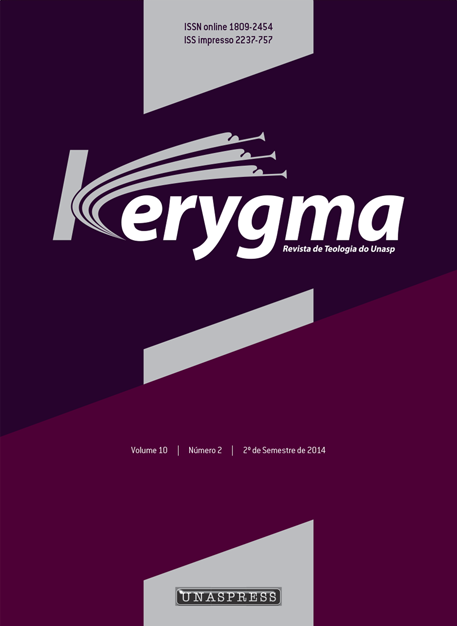Resumo
Grande parte da vida sociorreligiosa que os cristãos exteriorizam e objetivam ao interagir com Deus através da adoração congregacional requer uma análise interpretativa. O sentido religioso que o cristão encontra no ritual de adoração, baseado na consciência religiosa intersubjetiva bíblica da relação dialógica Deus-homem, permite avançar na compreensão da formação e conservação de fé, isto é, na construção e atualização de uma consciência religiosa intersubjetiva. Para isso, o presente artigo usa o método teológico de Bernard Lonergan e os quatro níveis de consciência (empírico, intelectual, racional e responsável), conectado com o modelo pastoral de ver, julgar e agir; e com os três tipos ideais de Jürgen Habermas sobre o perfil ético-professional do cientista social (técnico, prático e dialógico).
Palavras-chave: Consciência Religiosa Intersubjetiva; Níveis de Consciência; Consciência Bíblica.
Abstract: Much of the socio-religious life that Christians externalized and are intended to interact with God through congregational worship requires an interpretative analysis. The religious sense that the Christian finds in ritual worship, based on the biblical religious consciousness of intersubjective dialogic relationship God-man, up through the understanding of the formation and preservation of faith, that is, in building and updating an inter-subjective religious consciousness. In order to do this, the present article uses the theological method of Bernard Lonergan and the four levels of consciousness (empirical, intellectual, rational and responsible), connected with the pastoral model to see, judge and act; and the three ideal types of Jürgen Habermas on the ethical and professional profile of the social scientist (technical, practical and dialogical).
Keywords: Religious inter-subjective consciousness; Awareness levels; Biblical consciousness.
Referências
AUSTIN MILLÁN, T. Dos momentos en la teoría de Jurgen Habermas, 2000. Disponível em: http://bit.ly/ZWZRSu.
BERGER, P.; LUCKMANN, T. La construcción social de la realidad. Buenos Aires: Amorrortu editores, 1999.
GEERTZ, C. La interpretación de las culturas. Barcelona: Editorial Gedisa, 2005.
HABERMAS, J. Teoría de la Acción Comunicativa. Madrid: Taurus, 1987.
MARZAL, M. Tierra encantada. Tratado de antropología religiosa de América Latina. Lima: Editorial Trota, 2002.
RICOEUR, P. El mal. Un desafío a la filosofía y a la teologia. Buenos Aires: Amorrortu editores, 2007.
RITZER, G. Teoría sociológica contemporânea. Madrid: McGraw-Hill, 1993.
SCANNONE, J. C. Religión y nuevo pensamento: hacia una filosofía de la religión para nuestro tiempo desde América Latina. Barcelona: Anthropos Editorial, 2005.
Autores que publicam na Kerygma devem concordar com os seguintes termos:
- Uma vez aceitos para a publicação, os direitos autorais dos artigos são automaticamente transferidos à Kerygma.
- Todo material utilizado no texto que possua direitos autorais de terceiros devem estar devidamente referenciados.
- Os autores também devem deter os direitos de reprodução das imagens e tabelas em seu material, caso seja necessário.
- Os autores garantem que o texto submetido é de sua inteira autoria e não foi submetido e/ou publicado em nenhum outro local.
- As opiniões, ideias e conceitos emitidos nos textos são de inteira responsabilidade de seus autores e não representam, necessariamente, a opinião da Kerygma;
- É reservado aos editores o direito de proceder a ajustes textuais e de adequação às normas da publicação.
- Autores mantém os direitos autorais e concedem à revista o direito de primeira publicação, com o trabalho simultaneamente licenciado sob a Creative Commons Atribuição-NãoComercial 4.0 Internacional, que permite o compartilhamento do trabalho com reconhecimento da autoria e publicação inicial nesta revista. Essa licença permite que outros remixem, adaptem e criem a partir do seu trabalhopara fins não comerciais, e embora os novos trabalhos tenham de lhe atribuir o devido crédito e não possam ser usados para fins comerciais, os usuários não têm de licenciar esses trabalhos derivados sob os mesmos termos.
- Os autores concordam com a reprodução livre de seu material pela Kerygma, que poderá adaptar, modificar, condensar, resumir, reduzir, compilar, ampliar, alterar, mixar com outros conteúdos, incluir imagens, gráficos, objetos digitais, infográficos e hyperlinks, ilustrar, diagramar, fracionar, atualizar, traduzir e realizar quaisquer outras transformações, sendo necessária a participação ou autorização expressa dos autores.
- Os autores concordam que a Kerygma pode distribuir os artigos mediante cabo, fibra ótica, satélite, ondas ou qualquer outro sistema que permite acesso ao usuário em tempo e lugar determinados, seja por vias gratuitas ou por sistemas que importem pagamento. A Kerygma poderá ainda incluir o trabalho em banco de dados, físico ou virtual, arquivar em formato impresso, armazenar em computador, em sistema de nuvem, microfilmar e demais formas de arquivamento atuais ou que ainda possam ser desenvolvidas, com ou sem fins lucrativos.
- Autores têm autorização para assumir contratos adicionais separadamente, para distribuição não-exclusiva da versão do trabalho publicada nesta revista (ex.: publicar em repositório institucional ou como capítulo de livro), com reconhecimento na nova publicação que o artigo foi publicado originalmente nesta revista.
- A Kerygma é detentora dos direitos de todos os trabalhos publicados por ela. A reprodução integral desses textos em outras publicações, para qualquer outra finalidade, por quaisquer meios, requer autorização por escrito do editor. O mesmo serve para reproduções parciais, como resumo, abstract, porções com mais de 500 palavras do texto, tabelas, figuras, ilustrações etc.
- Autores têm permissão e são estimulados a publicar e distribuir seu trabalho online (ex.: em repositórios institucionais ou na sua página pessoal) a qualquer ponto antes ou durante o processo editorial, já que isso pode gerar alterações produtivas, bem como aumentar o impacto e a citação do trabalho publicado (veja “The effect of open access and downloads ('hits') on citation impact: a bibliography of studies”).

